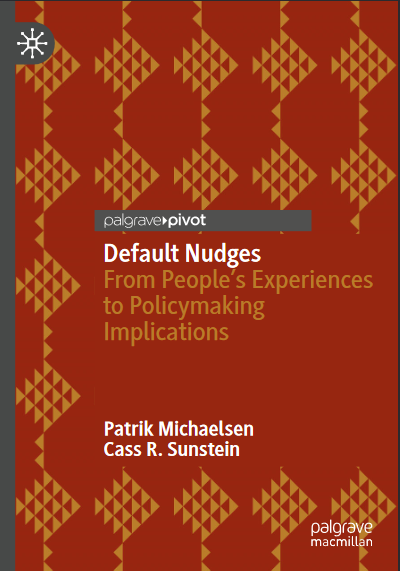1 THE PROBLEM 3 A common concern, however, is that targeted interventions, informa- tion campaigns, and educative nudges may turn out to be ineffective at changing people’s behavior (e.g., Conly, 2013). People might not pay attention to the information, perhaps because of unrealistic opti- mism, perhaps because of limited attention. They might give information less weight than they should, given its importance; they might dismiss information simply because they do not want to believe it. Mandates and bans are at the opposite pole from educative nudges, and they are frequently effective in changing behavior. Many people believe that the best way to stop a behavior is simply to forbid it. Offenses we consider very serious, such as murder and rape, are forbidden, and their occurrences are in all likelihood lower as a result. A somewhat less gruesome example: in Sweden in the early eighties, seat belt use was mandatory only for people riding in the front of the car, and few people used it riding in the back. When the law later changed to require seat belt use also in the rear, rear seat belt use more than doubled in the week after the law was implemented (Lacko & Nilsson, 1988). (And today, anecdotally, close to everyone uses it.) At the same time, what may be gained in effectiveness may be lost in respect for the decision-maker’s autonomy; for better or for worse, making certain acts punishable is a clear restriction on freedom of choice. In some cases, mandates are too crude. They might not sufficiently respect the diversity of people’s preferences, values, tastes, and situations. Whether and when mandates and bans are justified is one of the largest questions in all of moral and political philosophy. John Stuart Mill famously argued on behalf of the Harm Principle, urging that people should have freedom of choice unless they create harm to others. In On Liberty, Mill (2002) insisted: The only purpose for which power can be rightfully exercised over any member of a civilized community, against his will, is to prevent harm to others. His own good, either physical or moral, is not a sufficient warrant. He cannot rightfully be compelled to do or forbear because it will be better for him to do so, because it will make him happier, because, in the opinion of others, to do so would be wise, or even right.
چکیده فارسی
1 مشکل 3، با این حال، یک نگرانی رایج این است که مداخلات هدفمند، کمپین های اطلاعاتی، و تحریکات آموزشی ممکن است در تغییر رفتار افراد بی اثر باشند (به عنوان مثال، Conly، 2013). مردم ممکن است به اطلاعات توجه نکنند، شاید به دلیل خوش بینی غیر واقعی، شاید به دلیل توجه محدود. آنها ممکن است با توجه به اهمیت اطلاعات، وزن کمتری نسبت به آنها بدهند. آنها ممکن است اطلاعات را صرفاً به این دلیل که نمی خواهند آن را باور کنند رد کنند. دستورات و ممنوعیت ها در قطب مخالف تحریکات آموزشی قرار دارند و اغلب در تغییر رفتار مؤثر هستند. بسیاری از مردم بر این باورند که بهترین راه برای متوقف کردن یک رفتار صرفاً منع آن است. جرایمی که ما آنها را بسیار جدی می دانیم، مانند قتل و تجاوز، ممنوع هستند و در نتیجه وقوع آنها به احتمال زیاد کمتر است. یک مثال کمتر وحشتناک: در سوئد در اوایل دهه هشتاد، استفاده از کمربند ایمنی فقط برای افرادی که در جلو اتومبیل سوار می شدند اجباری بود و افراد کمی از آن در عقب سواری استفاده می کردند. زمانی که قانون بعداً تغییر کرد و استفاده از کمربند ایمنی در عقب را نیز الزامی کرد، استفاده از کمربند ایمنی عقب در هفته پس از اجرای قانون بیش از دو برابر شد (لاکو و نیلسون، 1988). (و امروزه، به طور حکایتی، نزدیک به همه از آن استفاده می کنند.) در عین حال، آنچه ممکن است در اثربخشی به دست آید، ممکن است در احترام به استقلال تصمیم گیرنده از بین برود. چه خوب و چه بد، مجازات کردن برخی اعمال، محدودیت آشکاری بر آزادی انتخاب است. در برخی موارد، دستورات بیش از حد خام هستند. آنها ممکن است به اندازه کافی به تنوع ترجیحات، ارزش ها، سلیقه ها و موقعیت های افراد احترام نگذارند. این که آیا دستورات و ممنوعیتها توجیه میشوند یا نه، یکی از بزرگترین پرسشها در تمام فلسفه اخلاقی و سیاسی است. جان استوارت میل به نمایندگی از اصل آسیب استدلال کرد و تاکید کرد که مردم باید آزادی انتخاب داشته باشند مگر اینکه آسیبی به دیگران وارد کنند. میل (2002) در «در آزادی» اصرار داشت: تنها هدفی که برای آن می توان به درستی بر هر عضو یک جامعه متمدن، برخلاف میل او اعمال قدرت کرد، جلوگیری از آسیب به دیگران است. خیر خودش، چه جسمی و چه اخلاقی، ضمانت کافی نیست. او را نمی توان به درستی مجبور به انجام دادن یا تحمل کرد، زیرا انجام این کار برای او بهتر است، زیرا این کار او را خوشحال تر می کند، زیرا به عقیده دیگران، انجام این کار عاقلانه یا حتی درست است.
ادامه ...
بستن ...
Patrik Michaelsen
Department of Psychology
University of Gothenburg
Gothenburg, Sweden
Cass R. Sunstein
Harvard Law School
Harvard University
Cambridge, MA, USA
ISBN 978-3-031-21557-5 ISBN 978-3-031-21558-2 (eBook)
https://doi.org/10.1007/978-3-031-21558-2
© The Author(s), under exclusive license to Springer Nature Switzerland AG 2023
This work is subject to copyright. All rights are solely and exclusively licensed by the
Publisher, whether the whole or part of the material is concerned, specifically the rights of
reprinting, reuse of illustrations, recitation, broadcasting, reproduction on microfilms or in
any other physical way, and transmission or information storage and retrieval, electronic
adaptation, computer software, or by similar or dissimilar methodology now known or
hereafter developed.
The use of general descriptive names, registered names, trademarks, service marks, etc.
in this publication does not imply, even in the absence of a specific statement, that such
names are exempt from the relevant protective laws and regulations and therefore free for
general use.
The publisher, the authors, and the editors are safe to assume that the advice and informa-
tion in this book are believed to be true and accurate at the date of publication. Neither
the publisher nor the authors or the editors give a warranty, expressed or implied, with
respect to the material contained herein or for any errors or omissions that may have been
made. The publisher remains neutral with regard to jurisdictional claims in published maps
and institutional affiliations.
Cover illustration: © Harvey Loake
This Palgrave Macmillan imprint is published by the registered company Springer Nature
Switzerland AG
The registered company address is: Gewerbestrasse 11, 6330 Cham, Switzerland
ادامه ...
بستن ...










